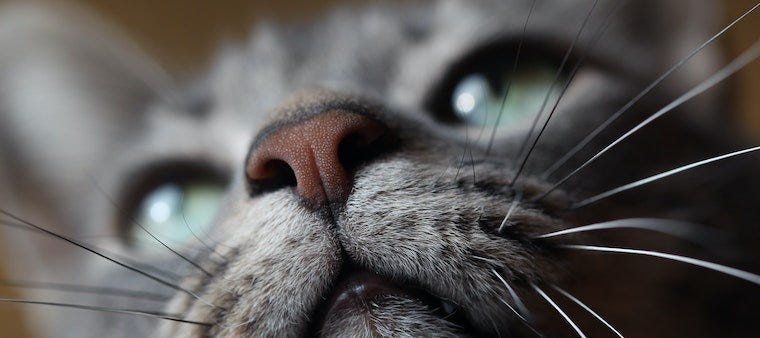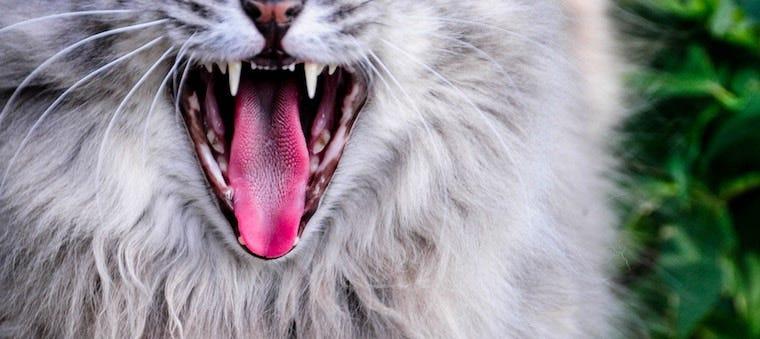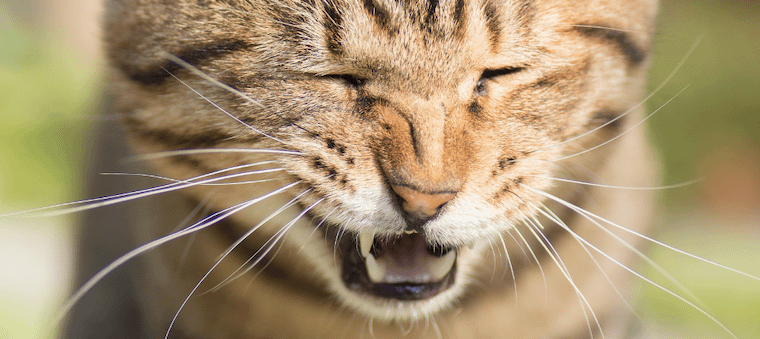While cat sneezes may be one of the cutest noises you’ve ever heard, they could also cause concern in some cases. If you’re asking yourself, "Why is my cat sneezing so much?" pay close attention to your feline so you can identify if other symptoms are present. While it could be as simple as your cat having an allergy, you will want to figure out what is causing your cat to sneeze so that you can take the proper measures to improve it.
You may need to take your cat to the veterinarian to rule out any serious medical issues. Like humans, cats can suffer from upper respiratory and sinus infections and other conditions that might lead to those adorable little sneezes. Being on top of changes in your cat’s behaviors and health can make for a healthy kitty and a less stressed-out pet parent.
Here's what you need to know about your cat sneezing and if there's any reason to worry.
Should I be worried?
The occasional sneeze from your cat is usually nothing to be concerned about—it may just be something irritating their nasal passage. Just like with humans, sneezing is normal and happens from time to time. If it’s more than occasional, you’ll want to look for patterns in your cat’s behavior.
Try to notice if it happens around the same time of day or only in a particular room. This can help determine if your cat’s sneezing is due to an irritant or if an infection or underlying condition causes it. Monitor your cat for other symptoms, along with frequent sneezing so that you can present as much information as possible to your cat’s vet. But first, let's determine why your cat might be sneezing.
Reasons why cats sneeze
Cats sneeze for various reasons: some are as innocent as a tickle in their nasal passage. Others are as serious as an upper respiratory infection, a foreign object stuck in the nose, or even pneumonia. As long as you keep an eye on your pet, you should be able to better determine the underlying cause of their sneezes.
By paying attention to your cat’s behaviors, you may figure out the problem without going to the veterinarian. Still, a second opinion from a professional is never a bad idea.
There may be a simple solution that you have to try before seeing positive results, or you may need to seek treatment or medication to help with your cat’s sneezing. There are various reasons your cat could be sneezing so much, so here are a few of the most common answers.
Upper respiratory infections (URIs) in cats
One of the common reasons for sneezing is an upper respiratory infection in your cat. Respiratory infections are similar to your cat having a common cold and show many of the same symptoms we associate with people getting a cold (like a runny nose or coughing).
Upper respiratory infections can be viral, bacterial, and fungal. These infections can last anywhere from 7 to 21 days but average 7 to 10 days.
One of the most common URIs that your cat might have is feline herpesvirus or FHV. It’s estimated that up to 90% of all cats have feline herpes, and though highly prevalent, it can be managed so that your cat lives a normal and happy life.
Many kittens are exposed to FHV at a young age and carry the virus in their bodies. It may lay dormant until the cat becomes stressed or immunosuppressed, where it then reemerges, causing unpleasant flare-ups.
If you have multiple cats, you may wonder why all your cats are sneezing. Remember that just like the common cold, upper respiratory infections in cats are contagious and can easily spread to other cats in the home.
Sinus infection
Your cat could also be suffering from an inflammatory condition like rhinitis and sinusitis. Your cat will display similar symptoms with these two conditions. Rhinitis is what humans refer to as a “stuffy nose,” as it is inflammation of the mucous membranes in the nose.
Sinusitis is inflammation in the lining of the sinuses. These two conditions also often occur together as rhinosinusitis.
To diagnose a cat with rhinosinusitis, rhinitis, or sinusitis, bring them to the vet for a thorough evaluation. Your vet might perform a rhinoscopy, when a small endoscope is inserted into the nose or mouth to better visualize the nasal passage and structure.
Antibiotics may be prescribed to help with inflammation, and steroids may be used to help open up the nasal cavities. If there is severe damage, your cat may need fluids and nutritional support while they fight off the infection.
Some signs a cat may be experiencing a sinus infection are:
- Nasal discharge – clear if mild, or yellow, green, or bloody if severe
- Difficulty breathing, more instances of snoring
- Discharge at the eyes
- Pawing at the face
- A lump on the bridge of the cat’s nose
- Reverse sneezing
Chronic upper respiratory conditions
If a cat has permanent damage to their nasal passages and a compromised immune system—like with feline immunodeficiency virus (FIV)—it could lead to chronic upper respiratory conditions and constant sneezing. Symptoms of a chronic condition are similar to upper respiratory infections and inflammation but persist over weeks or months or in intervals of a few weeks. Chronic rhinitis can also lead to recurring bacterial infections.
In addition, cats that have recovered from severe acute viral infections like feline calicivirus and feline herpesvirus are more susceptible to chronic upper respiratory conditions. With chronic conditions, you have to understand the underlying issues your cat is experiencing to treat them properly. Blood work, small biopsies, and X-rays can help determine the problem.
Inflammation or a tooth infection
Dental disease can cause sneezing, especially if the infection is at the root of the tooth. When cats have tooth infections, bacteria can establish in the sinuses. This results in inflammation, along with frequent sneezing.
Sneezing as a result of dental disease happens because the wall between the tooth hole and nasal passage can be breached, and bacteria can travel to other parts of your cat’s body that way.
This can be extremely painful, and your cat will likely show signs of discomfort if this is the case. They may have a swollen mouth and be unable to chew their food or drink water effectively. Without treatment, these problems will only worsen.
Allergies
In most cases, symptoms of allergies in cats present skin irritation or hair loss. However, other symptoms can arise, like your cat coughing, sneezing, wheezing, and itchy and watery eyes.
Symptoms of allergies can occur seasonally due to outdoor allergens like pollen or year-round allergens like dust or mold. Introducing a new type of cat litter or cleaning product to your household might also be the culprit. Remember that if you let your cat go outside, they are more exposed to chemicals in fertilizers. Indoor cats can also come in contact with house plants that can cause allergic reactions.
Irritations
Your cat could be sneezing for simple reasons, such as something momentarily irritating their nose and sinuses. This is probably the most obvious reason for sneezing and nothing to be concerned about! Irritants include mild chemical smells, airborne particles, or a nose tickle.
Irritants can also include:
- Cleaning products
- Cat litter types
- Cigarette smoke
- Perfume
- A foreign body sticking to the nose
You may notice that when you cook with certain spices, your cat sneezes more. Certain products that you use in your house may also impact your cat’s sneezing fits, so paying attention to when they sneeze and what they’re around when they do it can help your conversation with your vet.
What are the symptoms of allergies in cats?
Allergic reactions occur when a cat’s immune system overreacts to foreign substances or particles. These are some of the symptoms of cat allergies to look out for:
- Skin itchiness that causes scratching, rubbing, or head shaking
- Sneezing
- Coughing or wheezing
- Vomiting
- Diarrhea
- Gas
- Bloating
While you can’t protect your cat from every allergen, you can help keep germs and unwanted particles at bay in a litter box with the Cleaner Spray by Whisker. This cleaner uses bio-enzymatic technology combined with plant-based cleaners.
It is an all-natural cleaner that digests and eliminates organic material, stains, and odors in the cat’s litter box (or elsewhere around the house).
Cat keeps sneezing: FAQs
We all love our pets. We want what is best for our feline friends and to be on top of their health. Thinking about our precious kitten being in pain or uncomfortable is the opposite of what we want as pet parents. Because of this, we’ve compiled a few frequently asked questions to help ease your anxiety about your pet’s health and guide you toward the right decisions.
Is it normal for a cat to sneeze multiple times in a row?
A sneeze here and there from your cat is normal and nothing to worry about. You may even notice your cat has a sneezing fit and sneezes multiple times in a row, which is also standard. What isn’t normal is if your cat sneezes several times a day and for several days in a row. Frequent and consistent sneezing means it may be time for a trip to the vet.
Is it bad if your cat sneezes a lot?
The occasional sneeze is harmless. However, if your cat is sneezing multiple times a day for several days or if other symptoms are present, contact your vet.
If your cat is healthy and lets out the occasional sneeze, you probably have nothing to worry about. Take your feline friend to the vet for a yearly physical or as recommended by your vet. You can also check your cat's head and face between vet visits to look for abnormalities like discharge from the eyes or nose.
If you notice your cat coughing and sneezing, having trouble breathing, or showing signs of acting lethargic or having a decreased appetite and/or dehydration, take them to the vet immediately to rule out any major medical emergencies.
Should I take my sneezing cat to the vet?
Anytime sneezing persists or is accompanied by other symptoms like coughing, loss of appetite, drooling, or discharge from the eyes and nose, a visit to the vet is most likely needed to get the proper diagnosis and treatment.
Can indoor cats get a cold?
The pathogens that cause a cold in cats are usually airborne and can be brought into your home by another indoor/outdoor pet.
While not strictly a cold, cats can get Bordetella, also called “kennel cough.” Cats can catch this from dogs, so while your cat might stay indoors when your dog goes outside, this respiratory bacterial infection can carry. While the Bordetella vaccine can be given to both dogs and cats, it is only considered a core or essential vaccine for dogs. So if you’d like your cat to be vaccinated for it, you will need to request it at your next veterinarian appointment.
How to keep your cat healthy
Now that you know why your cat might be sneezing so much, you can stay on top of when sneezing is normal and when it's a cause for concern. Take your cat's health a step further with a self-cleaning litter box and the Whisker app.
Litter-Robot is a WiFi-enabled, self-cleaning litter box that gives you freedom from litter box duties while still allowing you to monitor your cat’s litter box health habits. With the Whisker app, you can monitor your cat's waste behavior to help you identify whether there are any other medical symptoms of concern. Litter-Robot makes caring for your cat easy!
Sources:
- Felid Herpesvirus Type 1 Infection in Cats: A Natural Host Model for Alphaherpesvirus Pathogenesis | NCBI
- Presumed Primary Bacterial Rhinosinusitis-Associated Optic Neuritis in a Cat | NCBI
- Feline Dental Disease | Cornell University College of Veterinary Medicine
- Feline Allergic Diseases: Introduction And Proposed Nomenclature | Veterinary Dermatology
- Bordetella in Cats | Rancho Cucamonga Vet
Cover photo by Kevin Knezic on Unsplash









